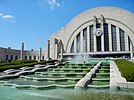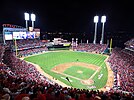
Back Cincinnati AF Cincinnati AN Sinsignātig ANG سينسيناتي (أوهايو) Arabic سينسيناتى ARZ Cincinnati AST Sinsinnati AZ سینسیناتی AZB Цынцынаці BE Цынцынаці BE-X-OLD
Cincinnati | |
|---|---|
| Nicknames: | |
| Motto(s): Juncta Juvant (Latin) "Strength in Unity" | |
 Interactive map of Cincinnati | |
| Coordinates: 39°06′00″N 84°30′45″W / 39.10000°N 84.51250°W | |
| Country | |
| State | |
| County | Hamilton |
| Settled | 1788 |
| Incorporated (town) | January 1, 1802[2] |
| Incorporated (city) | March 1, 1820[3] |
| Named for | Society of the Cincinnati and Cincinnatus |
| Government | |
| • Type | Mayor–council |
| • Body | Cincinnati City Council |
| • Mayor | Aftab Pureval (D) |
| • City manager | Sheryl Long |
| Area | |
• City | 79.64 sq mi (206.26 km2) |
| • Land | 77.91 sq mi (201.80 km2) |
| • Water | 1.72 sq mi (4.46 km2) |
| • Metro | 4,808 sq mi (12,450 km2) |
| Elevation | 742 ft (226 m) |
| Population (2020) | |
• City | 309,317 |
• Estimate (2023)[6] | 311,097 |
| • Rank | US: 64th |
| • Density | 3,969.98/sq mi (1,532.81/km2) |
| • Urban | 1,686,744 (US: 33rd) |
| • Urban density | 2,242.2/sq mi (865.7/km2) |
| • Metro | 2,265,051 (US: 30th) |
| • Demonym | Cincinnatian |
| GDP | |
| • Cincinnati (MSA) | $157.0 billion (2022) |
| Time zone | UTC−5 (EST) |
| • Summer (DST) | UTC−4 (EDT) |
| ZIP Codes | 452XX, 45999[8] |
| Area code | 513 and 283 |
| FIPS code | 39-15000[9] |
| GNIS feature ID | 1086201[5] |
| Website | cincinnati-oh |
Cincinnati (/ˌsɪnsɪˈnæti/ ⓘ SIN-sih-NAT-ee; nicknamed Cincy) is a city in and the county seat of Hamilton County, Ohio, United States.[10] Settled by Europeans in 1788, the city is located on the northern side of the confluence of the Licking and Ohio rivers, the latter of which marks the state line with Kentucky. The population of Cincinnati was 309,317 in 2020, making it the third-most populous city in Ohio and 64th-most populous in the U.S. The city is the economic and cultural hub of the Cincinnati metropolitan area, Ohio's most populous metro area and the nation's 30th-largest, with over 2.271 million residents.[11]
Throughout much of the 19th century, Cincinnati was among the top 10 U.S. cities by population. The city developed as a river town for cargo shipping by steamboats, located at the crossroads of the Northern and Southern United States, with fewer immigrants and less influence from Europe than East Coast cities in the same period. However, it received a significant number of German-speaking immigrants, who founded many of the city's cultural institutions. It later developed an industrialized economy in manufacturing. Many structures in the urban core have remained intact for 200 years; in the late 1800s, Cincinnati was commonly referred to as the "Paris of America" due mainly to ambitious architectural projects such as the Music Hall, Cincinnatian Hotel, and the Roebling Bridge.[12]
Greater Cincinnati has the 28th-largest economy in the U.S. and the fifth-largest in the Midwest, home to several Fortune 500 companies including Kroger, Procter & Gamble, and Fifth Third Bank.[13] It is home to three major professional sports teams: the Cincinnati Reds of Major League Baseball; the Cincinnati Bengals of the National Football League; and FC Cincinnati of Major League Soccer; it is also home to the Cincinnati Cyclones, a minor league ice hockey team. The city's largest institution of higher education, the University of Cincinnati, was founded in 1819 and is now ranked among the largest in the nation by enrollment.[14] The United States Court of Appeals for the Sixth Circuit is based in the city.
- ^ a b Luten, Winifred (January 11, 1970). "How Losantiville Became The Athens of the West". The New York Times. p. 411. Archived from the original on June 19, 2020. Retrieved June 18, 2020 – via The New York Times Archive.
- ^ Greve 1904, p. 27: "The act to incorporate the town of Cincinnati was passed at the first session of the second General Assembly held at Chillicothe and approved by Governor St. Clair on January 1, 1802."
- ^ Greve 1904, pp. 507–508: "This act was passed February 5, 2851, and by virtue of a curative act passed three days later took effect on March 1, of the same year."
- ^ "ArcGIS REST Services Directory". United States Census Bureau. Archived from the original on January 19, 2022. Retrieved September 20, 2022.
- ^ a b U.S. Geological Survey Geographic Names Information System: Cincinnati
- ^ "QuickFacts Cincinnati city, Ohio". United States Census Bureau. Retrieved May 16, 2024.
- ^ "Total Real Gross Domestic Product for Cincinnati, OH-KY-IN (MSA)". fred.stlouisfed.org. Archived from the original on October 21, 2019. Retrieved October 21, 2019.
- ^ "Zip Code Lookup". USPS. Archived from the original on February 11, 2012. Retrieved May 14, 2021.
- ^ "U.S. Census website". United States Census Bureau. Archived from the original on May 12, 2015. Retrieved January 31, 2008.
- ^ "Find a County". National Association of Counties. Archived from the original on June 8, 2011. Retrieved June 7, 2011.
- ^ "2020 Population and Housing State Data". United States Census Bureau, Population Division. August 12, 2021. Archived from the original on August 24, 2021. Retrieved August 14, 2021.
- ^ "When Cincinnati was 'the Paris of America'". Building Cincinnati. April 19, 2010. Archived from the original on April 19, 2012.
- Picturesque Cincinnati. Cincinnati, Ohio: John Shillito Company. 1883. p. 154. OCLC 3402849.
- Peterson, Lucas (July 13, 2016). "From Chili to the Underground Railroad, Cincinnati on a Budget". The New York Times. Archived from the original on February 16, 2018.
- Morgan, Michael D. (2010). "Side-Door Sundays in the Paris of America". Over-the-Rhine: When Beer Was King. Arcadia Publishing. ISBN 9781614231981. Archived from the original on March 27, 2024. Retrieved May 23, 2019.
- ^ Cite error: The named reference
cincinnati1was invoked but never defined (see the help page). - ^ Rieselman, Deborah. "Brief history of University of Cincinnati". UC Magazine. University of Cincinnati University Relations. Archived from the original on February 19, 2017. Retrieved February 12, 2014.











